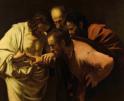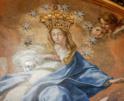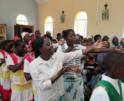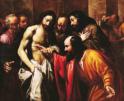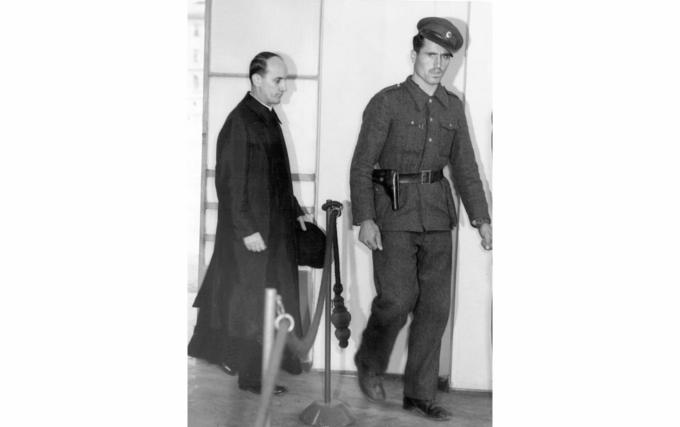
Faith
Once in power, Tito's first target was the Catholic Church, and particularly the Church in Croatia. And he went for its head, Bishop Stepinac, the Archbishop of Zagreb, Croatia's capital city.

Ryan
In 1380, Geoffrey Chaucer stirred the travel bug of Brits with his opening lines of the Canterbury Tales:
"When April with his showers sweet with fruit
And bathed each vein with liquor that has power
To generate therein and sire the flower...
Then do folk long to on pilgrimage...
To distant shrines well known in sundry land."
In 2016, when April came around, after months and months of political screaming and yelling... and the prospect ahead of us of six months more of gnashing of teeth, we decided we needed a break: a trip away for the noise seemed like the perfect idea. So off we set on a pilgrimage to Croatia and the nearby states of the former Yugoslavia.
The trip was driven in part by a desire to reconnect with family from the area, family that a hundred years ago decided to "stay home," rather than immigrate to the land where the streets were paved with gold. That part of the trip was richly rewarding as only family reconnection can be. The other motivation was to see firsthand what has happened in the last quarter century since we were in the region. That time was just as Yugoslavia, the faux nation the Communists had created and dominated for 35 years, began coming apart and the six nations began a bloody, 10 year civil war.
Croatia has been recently called by Vatican officials the most Catholic country in Europe. The percentage of Croats who identified themselves as Catholic had increased from 70 percent in 1989 to 90 percent in 2004, while the percentage of those listing "no religion" dropped from 18 percent to just 4 percent. Most surprisingly, "belief in God" increased from 39 percent in 1989 to 75 percent in 1996 and to 82 percent in 2004. While given the massive indifference of Europeans to religion (except perhaps to the recent arrival of Islamists!) the devotion of Croatians to the Mass and the sacraments is impressive.
This is particularly striking in light of the 55 years of persecution and oppression the Catholic Church underwent from Hitler's conquest of Croatia at the start of World War II through the end of Communist rule in 1991 -- or perhaps because of the persecution and oppression. In any event, the country's 4 million souls have only recently been free to practice their faith.
Besides the mega-conflicts first with Nazism and then Communism, the country was the scene of a personal religious face-off between Marshall Joseph Tito and now Blessed Aloysius Stepinac. Tito, the Croatian soldier who, when the Nazi arrived, went to the hills, put together an army of Parisians and launched, with the support of the Russians, one of the war's most effective resistance movements.
Besides a rich history of political antagonism, the area was, and is, religiously divided among Catholics, Greek Orthodox, and Muslims. Nevertheless, the handsome, charismatic Tito, trailing his heroic military achievements, was able, at war's end, and again with the aid of Stalin, to mold these disparate Balkan factions and regions into one nation: Yugoslavia.
Once in power, Tito's first target was the Catholic Church, and particularly the Church in Croatia. And he went for its head, Archbishop Stepinac, the Archbishop of Zagreb, Croatia's capital city. Ironically, Stepinac, who had courageously opposed the Nazis and saved many Jews from their clutches, was put on trial on trumped up charges of working with the Nazis and against Jews during the war. In a classic communist show trial, Archbishop Stepinac was found guilty, and given a 16 year prison sentence of hard labor.
In the meantime, the canny Tito maneuvered out from under Stalin's thumb and established what was called a Third Way, a brand of communism free from Russia's direct control. Under the suspect political theory that the enemy of my enemy is my friend, Tito began to be wooed by leaders in Washington and through the West. For decades he masterfully played the East against the West. All this time, Western leaders were casting a blind eye to Tito's oppression of the Church.
Over time, however, the imprisoned bishop became a symbol of Communism's cruel oppression of religion. Largely through pressure from Rome, Tito relented his sentence. Archbishop Stepinac was released from prison, and quietly exiled to his home village of Krasic. However, a year later, Pope Pius XII stunned the world by making the exiled prelate cardinal. Then Massachusetts born and bred, Cardinal Joseph Spellman of New York founded a high school in White Plains, N.Y. in Cardinal Stepinac's name. Other gestures followed and the eyes of the world saw the persecution that was going on, not just in Croatia, but throughout the Communist world.
In 1960, Cardinal Stepinac died of a blood disease while still under confinement in his parish. On Oct. 3, 1998, Pope John Paul II declared him a martyr and beatified him before a throng of 500,000 Croatians in Zagreb's cathedral. Today, Blessed Alojzije Stepinac is a national hero and a symbol of resistance to religious oppression.
In 1980, Tito died in splendor, but 10 years later Yugoslavia collapsed into one of the bloodiest civil wars of the 20th Century. Today he is an all but forgotten man. His monument is the 100,000 souls who lost their lives dismantling his social experiment: Yugoslavia.
- Kevin and Marilyn Ryan, editors of "Why I'm Still a Catholic," worship at St. Lawrence Church in Brookline, Mass.
Recent articles in the Faith & Family section
-
Wounds, not scarsJaymie Stuart Wolfe
-
A special collection in the liturgy libraryFather Robert M. O'Grady
-
Witness to a Transfiguration in KenyaMichele Miers
-
Understanding the ScripturesScott Hahn
-
'Cabrini' does extraordinary job of bringing saint to lifeBishop Nicholas DiMarzio

